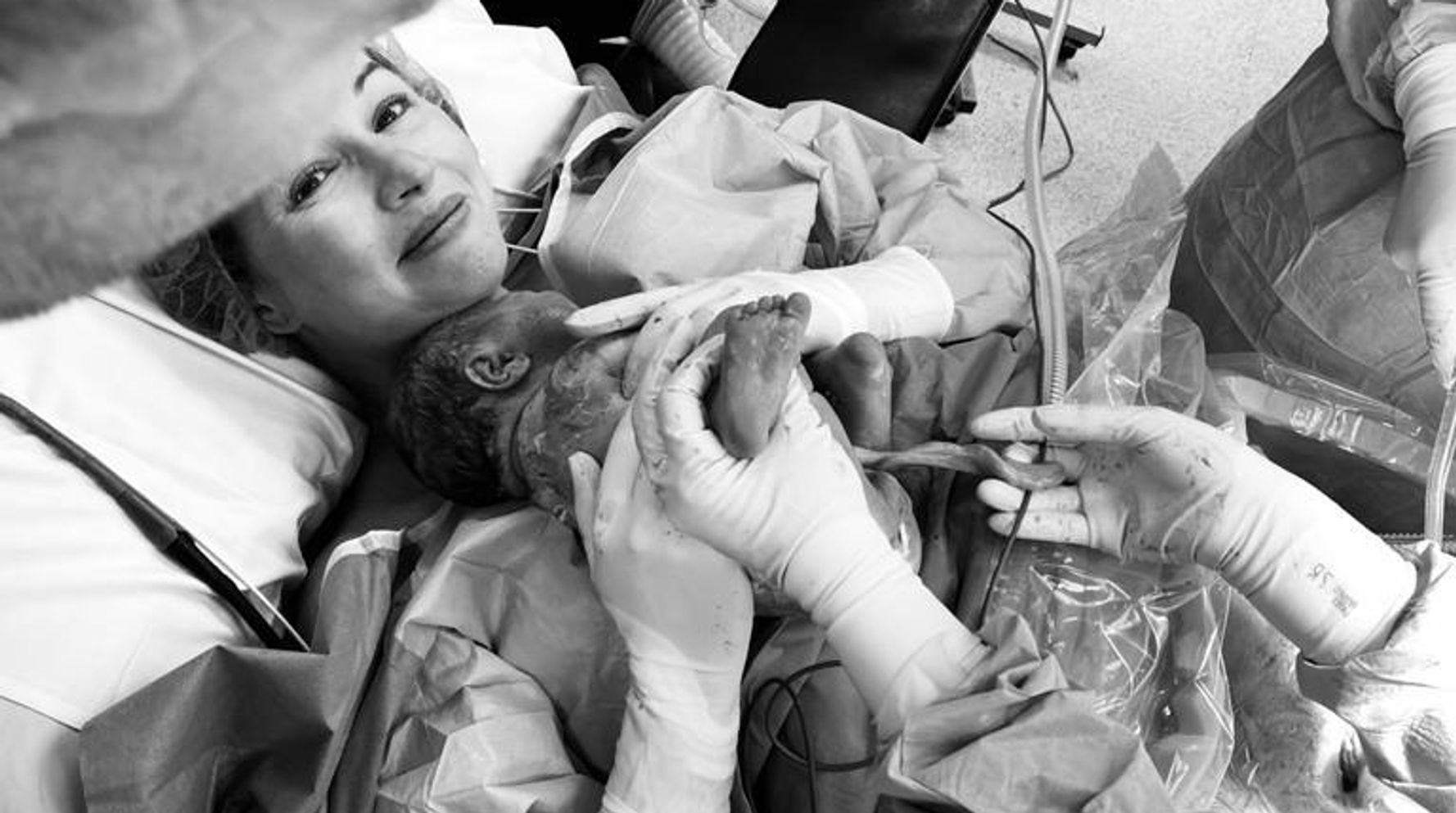Some People Are Taking Part In Their Own C-Sections. This Is How It Works
When you think of the moments following birth you picture a baby being placed on the mother's chest. Birthing mothers will occasionally reach down and grab their newborns themselves as Kourtney Kardashian famously did during giving birth to daughter Penelope in 2012.
"I remember always seeing scenes of women giving birth and feeling terrified so when I had my birth experience and it was so incredible and amazing I just remember wanting to share that to help other women maybe not feel terrified or have that perspective" Kardashian said last year in a Variety interview about the experience which aired on "Keeping Up with the Kardashians."
Even in the bare-it-all reality genre Kardashian catching her infants was rare. We're not used to witnessing a real newborn slick with blood and waxy vernix right after birth. We're also not used to witnessing a mother actively participating in her own birth in this manner.
When we hear about someone delivering their own baby it's usually because they gave birth in their car by accident or as part of a planned home birth.
But what if such an experience were made available to more birthing people including those who deliver through c-section as nearly one-third (32.2%) do? The concept of a woman engaging in her own operation may seem far-fetched but supporters of the method known as maternal-assisted caesarean argue that it is not only feasible but also beneficial to the women who opt for it.
What Exactly Is A Caesarean Section?
In a maternal-assisted caesarean the woman makes the same instinctual action that Kardashian did during her births however instead of reaching down between her legs to raise the baby to her chest she reaches toward the incision in her lower belly. (Note that she does not reach into the incision but instead grabs the baby after the head and shoulders have been removed by a doctor.)
This alters the appearance of the procedure largely by removing the drape that separates the patient's head and chest from the lower half of her body. She had a clear view of the surgery in addition to lifting her baby to her chest.
This means that a woman enters the surgery with her doctor meticulously scrubbing her hands and forearms with a nail brush before donning the sterile medical gloves she will wear when she reaches for her baby. Because such precautions are required to reduce the risk of infection only scheduled c-sections not emergency ones can be performed with maternal assistance. (Note that "emergency" denotes the c-section was unexpected not that anyone's life was in danger.)
Maternal-assisted caesareans are uncommon and not all doctors will agree to engage in one but women who have had this sort of c-section report that being allowed to participate in their delivery was well worth all of the debate planning and preparation.
What Are The Advantages?
Learning that she may need a c-section may create irritation or disappointment for a woman expecting for a vaginal birth and some control over her birth experience. Choosing a maternal-assisted caesarean can make the delivery experience more satisfying and meaningful for certain moms.
"I had a vaginal delivery for my first child and a c-section for my second" Lyz Evans an Australian physiotherapist (the term physical therapist is more commonly used in the United States) told HuffPost.
Evans used the adjectives "clinical" and "disconnected" to characterize her first c-section experience. She co-founded the Empowered Motherhood workout program. "You are numb from the chest down lying flat on your back and have a drape separating you from the birthing team and the surgery" she explained.
"The drape is removed so you can watch the procedure and because you are able to reach down and pull your baby out of your stomach yourself you feel like you are really involved in the process and that can be so empowering and incredible" Evans said of a maternal-assisted caesarean.
Evans first learned about maternal-assisted caesareans through South American social media and asked why the practice wasn't more commonly available. When she was planning for her third child she considered this option and how it would allow her to take a "active role."
The difficult part she added was convincing her doctor who had never performed a caesarean in this manner before and the hospital to accept it.
What Are The Safety Precautions?
The main safety worry is "the risk of contaminating the sterile field where the surgery is taking place" according to Dr. Josie Urbina an OB-GYN at the University of California San Francisco. Urbina performs standard c-sections and says that "usually patients are behind a non-sterile curtain accompanied by their partners doulas and the anesthesia team."
The removal of the curtain to allow the patient to reach down for her baby would make maintaining a sterile operating field problematic according to Urbina. The staff would have to think outside the box: "If there's a way to make the patient sterile to help receive their baby then that may decrease the risk of contamination and as a result decrease the risk of infection of their incision and/or uterus after c-section."
She claimed that an infection would "delay wound healing" and exacerbate pain. These infections can potentially be dangerous.
Only planned c-sections and low-risk pregnancies are candidates for the operation. Before consenting to do the procedure your doctor would need to examine your personal risk.
Despite these risks and restrictions the technique has advantages. "One of these is ensuring the patient feels involved and in control of their own birth experience" Urbina said.
"Assisting a patient with the delivery of their own baby through c-section can be a very satisfying and memorable experience for someone who had initially envisioned a vaginal birth" she said.
What Does Preparation Entail?
Evans claims that her doctor Lynn Townsend investigated the treatment weighed the dangers and agreed to execute it. She then lobbied the hospital board on Evans' behalf eventually obtaining consent for the surgery.
Evans stated that in the weeks leading up to the birth she and Townsend "discussed the logistics of the birth the importance of ensuring a sterile environment and practiced the steps involved."
Evans was required to do a surgical hand-wash and to put on a gown and sterile gloves while lying on her back.
"We practiced when I would reach down to deliver my baby from the abdomen and how quickly I would lift her to my chest to give Dr. Townsend enough time to check that the cord was long enough" Evans said.
Townsend emphasized to Evans that if the baby was in trouble or if her labor began spontaneously they would be unable to proceed with their plan.
Neither of those eventualities came true and on the day of the scheduled c-section Evans had a drastically different experience than she had with her prior births.
"It felt far less clinical than my first cesarean section and I felt far more connected to the procedure as well as everyone else in the room." "I was kept informed at every step of the way which made me feel like a part of the team" she said.
"I had watched every step of the surgery so by the time I reached down to lift her out I was so emotional from the build-up to this moment." "She cried as soon as she came out of the uterus and then like magic as soon as I placed her on my chest over my beating heart she settled" Evans explained.
Evans highlighted that the rapid skin-to-skin contact she described can also occur following a conventional c-section and that patients should inquire about this possibility with their doctors. This is becoming more common in hospitals.
"It was one of the most incredible moments of my life and it made it all worth it" she said.


